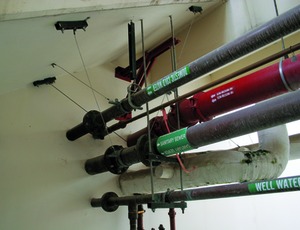
Seismic Design Group Inc. claims its new software will help users meet code requirements for non-structural seismic bracing for piping and other building utilities typically found in ceiling plenums and mechanical rooms. The SCoPe: Seismic Calculation Program is intended to help trade contractors choose the proper anchoring and suspension systems for a given seismic zone. The software is designed for use by the construction engineers of mechanical, electrical, plumbing and fire protection system contractors.
The program walks users through the process of identifying the correct 2006 or 2009 International Building Code requirements for their non-structural building components by capturing information on the location and type of structure being built.
Dan Dugan Sr., the software's creator, wants to make these calculations simple enough for anyone to do. “I see the codes as a math problem in algebra class,” says Dugan, “You have to display how you got your answers, and the software does that.”
To compute the non-structural anchoring and bracing systems, the program needs several inputs, including the mapped ground motions for the area, the seismic zone and building-type classifications. This software links to the U.S. Geological Survey's seismic maps to identify the correct information for the program.
Currently, trade contractors have to perform complex structural calculations for seismic sway braces. Or they can rely on the product distributors to specify the hardware for their projects, says Robert Bachman, a structural engineer based in Laguna Niguel, Calif.
The systems have to meet provisions of the American Society of Civil Engineers' Minimum Design Loads for Buildings and Other Structures, a standard known as ASCE/SEI 7.
Bachman, who has been active in standards development for 20 years, says responsibility for designing non-structural restraints is not clear. The exercise usually gets passed down from engineer to subcontractor and finally lands on the product distributors, says Bachman.
“Half of the subcontractors approached to do a [current] Salt Lake City project were unable to bid because they had no idea of the specs for the non-structural support systems,” says Maryann Phapps, president of structural engineer Estructure, El Cerrito, Calif.
The U.S. Embassy in Haiti underwent a real-world test of its seismic bracing systems during the 2010 earthquake. The embassy had cable bracing for its suspended non-structural building components—for example, plumbing and sprinkler systems—which withstood the test.
Supporting building infrastructure, especially in hospitals, is vital. “These systems go down, people die,” says Bill Nelson, president of Nelson Consulting Engineers, Irvine, Calif. “This program removes the guesswork for engineers who aren't as familiar with these calculations,” adds Nelson, who uses the software.
According to Bachman, most structural engineers aren't concerned with requirements for non-structural seismic bracing because non-structural components typically are not part of their contractual responsibilities.
“The trades want to do this bracing right. We just need to tell them how,” says Bachman. “It needs to be built into the bidding costs.”



Post a comment to this article
Report Abusive Comment